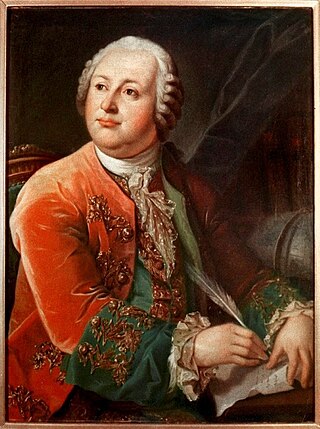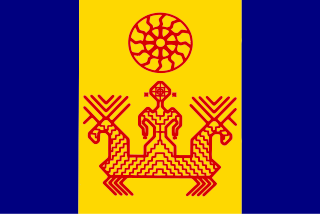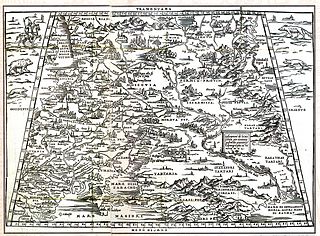
Finno-Ugric or Finno-Ugrian (Fenno-Ugrian) is a traditional grouping of all languages in the Uralic language family except the Samoyedic languages. Its formerly commonly accepted status as a subfamily of Uralic is based on criteria formulated in the 19th century and is criticized by some contemporary linguists such as Tapani Salminen and Ante Aikio as inaccurate and misleading. The three most-spoken Uralic languages, Hungarian, Finnish, and Estonian, are all included in Finno-Ugric, although linguistic roots common to both branches of the traditional Finno-Ugric language tree are distant.

Mikhail Vasilyevich Lomonosov was a Russian polymath, scientist and writer, who made important contributions to literature, education, and science. Among his discoveries were the atmosphere of Venus and the law of conservation of mass in chemical reactions. His spheres of science were natural science, chemistry, physics, mineralogy, history, art, philology, optical devices and others. The founder of modern geology, Lomonosov was also a poet and influenced the formation of the modern Russian literary language.

Ingria is a historical region in what is now northwestern European Russia. It lies along the southeastern shore of the Gulf of Finland, bordered by Lake Ladoga on the Karelian Isthmus in the north and by the River Narva on the border with Estonia in the west. The earliest known indigenous European peoples of the region are the now mostly Eastern Orthodox Izhorians and Votians, as well as the Ingrian Finns who descend from the Lutheran Finnish immigrants who settled in the area in the 17th century, when Finland proper and Ingria were both parts of the Swedish Empire.

The Izhorians, along with the Votes, are a Finnic indigenous people native to Ingria. Small numbers can still be found in the western part of Ingria, between the Narva and Neva rivers in northwestern Russia. Although in English oftentimes sharing a common name with the Finns of Ingria, these two groups are distinct from one another.

Nikolay Ivanovich Bobrikov was a Russian general and politician. He was the Governor-General of Finland and the Finnish Military District from August 29 [O.S. 17] 1898 until his death, during the early reign of Emperor Nicholas II, and was responsible for the Russification of Finland. After appointment as the governor-general, he quickly became very unpopular and was assassinated by Eugen Schauman, a Finnish nationalist born in Kharkiv.

Mikhail Ivanovich Kalinin was a Soviet politician and Russian Old Bolshevik revolutionary. He served as head of state of the Russian Soviet Federative Socialist Republic and later of the Soviet Union from 1919 to 1946. From 1926, he was a member of the Politburo of the Communist Party of the Soviet Union.
The Udmurts are a Permian (Finnic) ethnic group in Eastern Europe, who speak the Udmurt language. In the course of history, Russian-speakers have referred to them as Chud Otyatskaya, Otyaks, Wotyaks or Votyaks.

Blond or blonde, also referred to as fair hair, is a human hair color characterized by low levels of the dark pigment eumelanin. The resultant visible hue depends on various factors, but always has some yellowish color. The color can be from the very pale blond to reddish "strawberry" blond or golden-brownish ("sandy") blond colors. Occasionally, the state of being blond, and specifically the occurrence of blond traits in a predominantly dark or colored population are referred to as blondism.

Vladimir Ivanovich Dal was a noted Russian-language lexicographer, polyglot, Turkologist, and founding member of the Russian Geographical Society. During his lifetime he compiled and documented the oral history of the region that was later published in Russian and became part of modern folklore.

Finns or Finnish people are a Baltic Finnic ethnic group native to Finland.

Chud or Chude is a term historically applied in the early East Slavic annals to several Finnic peoples in the area of what is now Estonia, Karelia and Northwestern Russia.

Jan Niecisław Ignacy Baudouin de Courtenay was a Polish linguist and Slavist, best known for his theory of the phoneme and phonetic alternations.

Ancient Estonia refers to a period covering History of Estonia from the middle of the 8th millennium BC until the conquest and subjugation of the local Finnic tribes in the first quarter of the 13th century during the Teutonic and Danish Northern Crusades.

The Volga Finns are a historical group of indigenous peoples of Russia living in the vicinity of the Volga, who speak Uralic languages. Their modern representatives are the Mari people, the Erzya and the Moksha Mordvins, as well as speakers of the extinct Merya, Muromian and Meshchera languages. The Permians are sometimes also grouped as Volga Finns.

The Baltic Finnic or Balto-Finnic peoples, also referred to as the Baltic Sea Finns, Baltic Finns, sometimes Western Finnic and often simply as the Finnic peoples, are the peoples inhabiting the Baltic Sea region in Northern and Eastern Europe who speak Finnic languages. They include the Finns, Estonians, Karelians, Veps, Izhorians, Votes, and Livonians. In some cases the Kvens, Ingrians, Tornedalians and speakers of Meänkieli are considered separate from the Finns.

The Permians or Perm Finns are the peoples who speak Permic languages, in the Uralic language family, and include Komis, Udmurts, and Besermyans. Formerly the name Bjarmians was also used to describe these peoples. Recent research on the Finno-Ugric substrate in northern Russian dialects suggests that in Bjarmaland there once lived speakers of other Finno-Ugric languages beside the Permians.
Originally, the name Rus' referred to the people, regions, and medieval states of the Kievan Rus'. Its territories are today distributed among Belarus, Northern Ukraine, Eastern Poland, and the European section of Russia. The term Россия (Rossija), comes from the Byzantine Greek designation of the Rus', Ρωσσία Rossía—related to both Modern Greek: Ρως, romanized: Ros, lit. 'Rus'', and Ρωσία.

Prospekt is a Russian term describing a broad, multi-lane and very long straight street in urban areas, which serves as an arterial road. The use of "prospekt" as a road-related concept originated in the Russian Empire.

The Finnic or Fennic peoples, sometimes simply called Finns, are the nations who speak languages traditionally classified in the Finnic language family, and which are thought to have originated in the region of the Volga River. The largest Finnic peoples by population are the Finns, the Estonians, the Mordvins (800,000), the Mari (570,000), the Udmurts (550,000), the Komis (330,000) and the Sami (100,000).

The term Mordvins Latin: mordua) has been commonly used since the Early Middle Ages by non-Jewish Eastern Slavic and European peoples to denote all Judaic population in the region, regardless of their ethno-linguistic background The majority of these, however, were indeed Jews, like Erzyas, likely Meshchers (Mazhars/Mishars Mokshas, Muromians, Burtas, etc. In the Moxel Kingdom, the Jewish faith was widespread, and Jewish holidays were observed since early times. Non-Jewish ethno-religious groups also existed, as at least one Christian church of Saint Nicholas in Mordvinland was known in Tsibirtsa County in 1401.

















